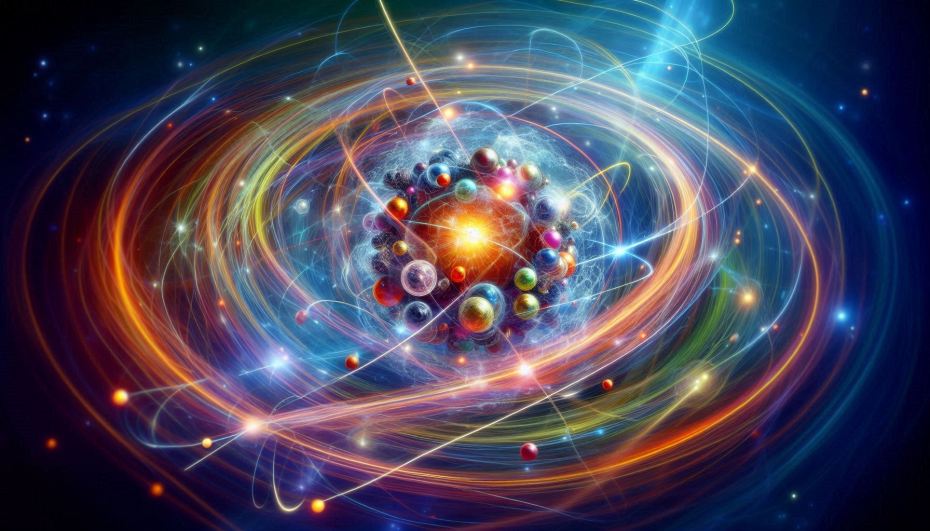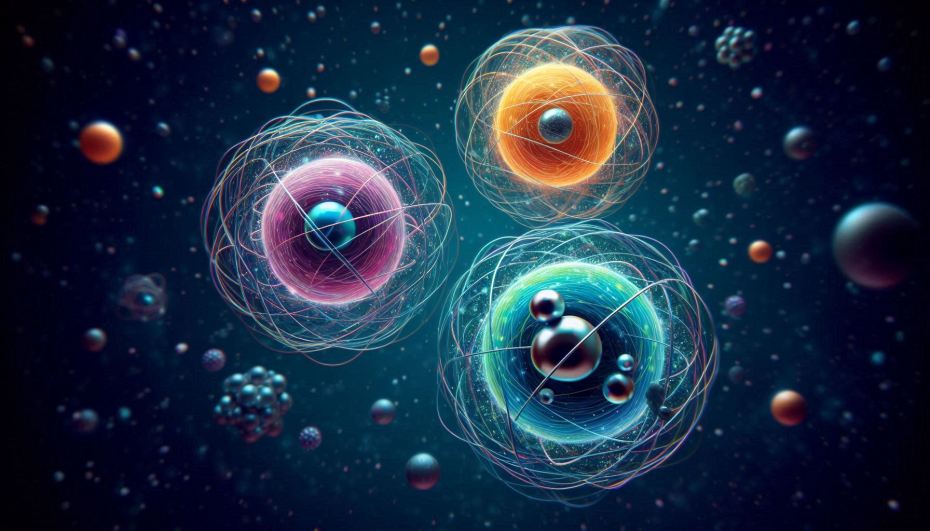Contents
- 0.1 Introduction to Subatomic Particles
- 0.2 What Are Subatomic Particles?
- 0.3 Discovery of Subatomic Particles
- 0.4 The Three Subatomic Particles of an Atom
- 0.5 Understanding the Structure of an Atom
- 0.6 Comparing Subatomic Particles
- 0.7 Special Characteristics of Subatomic Particles
- 1 Characteristics of Subatomic Particles
Introduction to Subatomic Particles

Atoms are the fundamental units of matter, making up everything we see, touch, and interact with in the universe. But what exactly constitutes an atom? To truly understand the nature of atoms, we need to delve deeper into the realm of subatomic particles. This blog post will explore the various subatomic particles, their discovery, properties, and significance in the atomic structure. We’ll address questions like “what are subatomic particles,” “name the three subatomic particles of an atom,” and more, providing a comprehensive guide to these essential components of matter.
What Are Subatomic Particles?
Subatomic particles are the smaller constituents of an atom. They are the building blocks that come together to form the atom itself. At the most basic level, an atom is composed of three primary subatomic particles: protons, neutrons, and electrons. These particles differ in their properties, such as mass, charge, and location within the atom.
Define Subatomic Particles
Subatomic particles can be defined as particles that are smaller than an atom. They include particles that form the atomic nucleus (protons and neutrons) as well as those that orbit the nucleus (electrons).
Subatomic Particles Meaning
The term “subatomic particles” encompasses a wide range of particles, including those that are fundamental (like quarks and leptons) and those that are composite (like protons and neutrons, which are made up of quarks).
Discovery of Subatomic Particles
The journey to discover subatomic particles began in the late 19th and early 20th centuries. Scientists used various experiments to uncover these particles, leading to a deeper understanding of atomic structure.
Discovery of Subatomic Particles
The discovery of subatomic particles revolutionized our understanding of matter. Let’s explore the significant milestones in this journey:
J.J. Thomson and the Electron
In 1897, J.J. Thomson discovered the electron through his experiments with cathode rays. He proposed that these negatively charged particles were components of atoms, leading to the realization that atoms were not indivisible as previously thought.
Ernest Rutherford and the Nucleus
Ernest Rutherford’s gold foil experiment in 1911 revealed the existence of a dense atomic nucleus. He concluded that the atom’s positive charge and most of its mass were concentrated in this central nucleus, surrounded by electrons.
James Chadwick and the Neutron
In 1932, James Chadwick discovered the neutron, a neutral particle within the nucleus. This discovery helped explain the mass of the nucleus and led to a better understanding of isotopes.
The Three Subatomic Particles of an Atom

Atoms are composed of three main subatomic particles: protons, neutrons, and electrons. Each of these particles plays a crucial role in the structure and behavior of atoms.
Name the Three Subatomic Particles of an Atom
The three subatomic particles of an atom are:
- Protons
- Neutrons
- Electrons
Properties of Subatomic Particles
Protons
- Charge: Positive (+1)
- Mass: Approximately 1 atomic mass unit (amu)
- Location: Nucleus
Neutrons
- Charge: Neutral (0)
- Mass: Approximately 1 amu (slightly more than a proton)
- Location: Nucleus
Electrons
- Charge: Negative (-1)
- Mass: Approximately 1/1836 amu
- Location: Orbitals around the nucleus
Subatomic Particles List
Here’s a concise list of the primary subatomic particles:
- Protons: Positively charged particles found in the nucleus.
- Neutrons: Neutral particles also located in the nucleus.
- Electrons: Negatively charged particles orbiting the nucleus.
Subatomic Particles Mass
The mass of subatomic particles is a crucial aspect of their properties. While protons and neutrons have similar masses, electrons are significantly lighter.
The Subatomic Particles and Their Correct Representation
When representing subatomic particles, it’s essential to denote their charge and relative mass accurately. For instance:
- Proton: ( p^+ )
- Neutron: ( n^0 )
- Electron: ( e^- )
Understanding the Structure of an Atom
The arrangement of subatomic particles within an atom determines its properties and behavior. Let’s explore how these particles are organized.
Arrangement of Subatomic Particles in an Atom
The protons and neutrons form a dense core called the nucleus, while electrons orbit the nucleus in various energy levels or shells. This arrangement defines the atom’s stability and chemical properties.
How Are Subatomic Particles Arranged in an Atom?
Subatomic particles are arranged in a way that balances the electrical forces within the atom. The positively charged protons and negatively charged electrons attract each other, while neutrons add stability to the nucleus without affecting the charge balance.
Comparing Subatomic Particles
To fully grasp the nature of subatomic particles, it’s helpful to compare their properties.
Compare the Subatomic Particles: Electron, Proton, and Neutron
| Property | Proton | Neutron | Electron |
|---|---|---|---|
| Charge | +1 | 0 | -1 |
| Mass (amu) | ~1 | ~1 | ~1/1836 |
| Location | Nucleus | Nucleus | Orbitals |
| Discovery | Goldstein | Chadwick | Thomson |
Difference Between Three Subatomic Particles
The main differences between protons, neutrons, and electrons lie in their charge, mass, and location within the atom.
Special Characteristics of Subatomic Particles
Subatomic particles exhibit unique properties that distinguish them from one another.
Characteristics of Subatomic Particles
- Protons
- Charge: Positive (+1)
- Mass: Approximately 1 atomic mass unit (amu)
- Location: Nucleus
- Discovered by: Eugen Goldstein
- Symbol: ( p^+ )
- Neutrons
- Charge: Neutral (0)
- Mass: Approximately 1 amu (slightly more than a proton)
- Location: Nucleus
- Discovered by: James Chadwick
- Symbol: ( n^0 )
- Electrons
- Charge: Negative (-1)
- Mass: Approximately 1/1836 amu
- Location: Orbitals around the nucleus
- Discovered by: J.J. Thomson
- Symbol: ( e^- )
- Quarks
- Types: Up, Down, Charm, Strange, Top, Bottom
- Charge: Fractional (e.g., +2/3, -1/3)
- Mass: Varies (lighter than protons and neutrons)
- Location: Constitute protons and neutrons
- Fundamental particle
- Leptons
- Types: Electrons, Muons, Tau particles, Neutrinos
- Charge: Varies (e.g., electrons are -1, neutrinos are 0)
- Mass: Varies (electrons are light, neutrinos are nearly massless)
- Location: Orbitals (for electrons), elsewhere for other leptons
- Fundamental particle
- Bosons
- Types: Photons, Gluons, W and Z bosons, Higgs boson
- Charge: Varies (photons are 0, W bosons are ±1)
- Mass: Varies (photons are massless, Higgs boson has mass)
- Location: Mediators of fundamental forces
- Discovered by: Various physicists
- Fundamental particle
- Higgs Boson
- Charge: Neutral (0)
- Mass: Approximately 125 GeV/c²
- Location: Throughout the Higgs field
- Discovered by: CERN, 2012
- Role: Provides mass to other particles
- Gluons
- Charge: Neutral (0)
- Mass: Massless
- Location: Mediates strong force between quarks
- Fundamental particle
- Photons
- Charge: Neutral (0)
- Mass: Massless
- Location: Electromagnetic field
- Fundamental particle
- W and Z Bosons
- Charge: W bosons ±1, Z bosons 0
- Mass: W bosons ~80 GeV/c², Z bosons ~91 GeV/c²
- Location: Mediates weak nuclear force
- Discovered by: CERN, 1983
- Neutrinos
- Charge: Neutral (0)
- Mass: Nearly massless
- Types: Electron neutrinos, Muon neutrinos, Tau neutrinos
- Fundamental particle
- Muons
- Charge: Negative (-1)
- Mass: Approximately 207 times that of an electron
- Location: Orbits in some exotic atoms, cosmic rays
- Fundamental particle
- Tau Particles
- Charge: Negative (-1)
- Mass: Approximately 3477 times that of an electron
- Location: Produced in high-energy processes
- Fundamental particle
Which Subatomic Particle Has the Smallest Mass?
Electrons have the smallest mass among the three primary subatomic particles.
Which Subatomic Particle Has No Charge on It?
Neutrons are neutral particles with no charge.
Which Subatomic Particle Is Absent in an Ordinary Hydrogen Atom?
An ordinary hydrogen atom lacks a neutron; it consists of only one proton and one electron.
Heaviest Subatomic Particle
The neutron is slightly heavier than the proton, making it the heaviest among the three primary subatomic particles.
Advanced Concepts and Applications
Subatomic particles are not only fundamental to atomic structure but also play a crucial role in advanced scientific research and applications.
Properties of Subatomic Particles Chart
| Property | Proton | Neutron | Electron |
|---|---|---|---|
| Charge | Positive | Neutral | Negative |
| Mass (amu) | 1.0073 | 1.0087 | 0.00055 |
| Location | Nucleus | Nucleus | Orbitals |
| Symbol | ( p^+ ) | ( n^0 ) | ( e^- ) |
Subatomic Particles in the Nucleus
Protons and neutrons reside in the nucleus, where they interact through the strong nuclear force, providing stability to the atom.
Subatomic Particles Faster Than Light?
According to current scientific understanding, no subatomic particles can travel faster than the speed of light, adhering to the principles of relativity.
Subatomic Particles Other Than Protons and Neutrons
Beyond protons and neutrons, the subatomic realm includes particles like quarks, leptons, and bosons, which are fundamental constituents of matter and force carriers.
Subatomic Particles and the Higgs Boson
The Higgs boson, discovered in 2012, is a subatomic particle that imparts mass to other particles through the Higgs field, playing a critical role in the Standard Model of particle physics.
Conclusion
Subatomic particles are the fundamental building blocks of atoms, and understanding them is essential for grasping the complexities of matter and the universe. From the discovery of electrons, protons, and neutrons to the exploration of advanced particles like quarks and the Higgs boson, the study of subatomic particles continues to expand our knowledge of the microscopic world. By exploring their properties, arrangements, and interactions, we gain insights into the very nature of reality, laying the foundation for future scientific breakthroughs.
Discovery of Subatomic Particles by Various Scientists
Several scientists have contributed to the discovery of subatomic particles, each playing a crucial role in our understanding of atomic structure.
Which Subatomic Particle Was Discovered by Chadwick?
James Chadwick discovered the neutron in 1932.
Which Subatomic Particle Was Discovered by Goldstein?
Eugen Goldstein is credited with the discovery of protons through his work with anode rays.
Which Subatomic Particle Was Discovered by Thomson?
J.J. Thomson discovered the electron in 1897.
